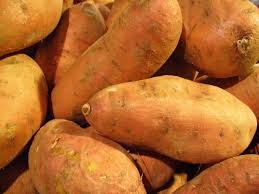Sweet Potatoes and Leaves are Easy to Grow, Tolerant of Adverse Conditions with Few Pests and Diseases
GROWING TIPS:
The sweet potato and its leaves are good choices for the global garden because they are easy to grow, they are drought-tolerant and heat-tolerant, and there are very few pests or diseases associated with their growing.
Here are some basic planting, caring and harvesting strategies for sweet potatoes:
Soil Analysis
- Before planting the sweet potatoes, have the soil tested to determine if there are any nutrient deficiencies or moisture-related concerns. You can send soil samples to the University of Connecticut for evaluation. Here is a link to the information: http://www.soiltest.uconn.edu/sampling.php
- During the planting you can monitor the soil condition and weather conditions to assure optimum care for optimum harvest using EDYN wireless garden sensors. EDYN’s real time information on above ground and below ground conditions can help assure optimum soil conditions for an optimum harvest, including averting rot caused by excessive watering in the later stages of growing. You can purchase EDYN sensors for $99 at Home Depot, hook them up to your wireless network and view the ongoing measurements via your Apple or Andriod cellphone. Here are links to the EDYN and Home Depot websites:
Planting
-
Prepare the soil with no-till techniques such as just turning over the grass via a shovel as part of an strategy to generate an optimal harvest.
-
The best way to grow sweet potatoes at first is from slips. Slips are sprouts that are grown from stored sweet potatoes. You can buy slips from garden centers, nurseries, local farmers or on-line
-
At the garden, create raised soil beds 6 to 8 inches tall and about 12 inches wide. Use fertile, well-drained soil.
-
Plant the slips 12 to 18 inches apart in the bed, after the last spring frost date.
-
Plant the slips deep enough to cover the roots and about 1/2 inch of the stem. Water the slips with a starter solution that is high in phosphorous, then water generously for a few days to make sure that the plants root well
-
Care
-
Based on the soil analysis, evaluate the need for treating the potatoes 3 to 4 weeks after transplanting with 3 pounds of 5-10-10 fertilizer per 100 feet of row. If you have sandy soil, use 5 pounds.
-
Hoe the beds occasionally to keep weeds down. Remember to reshape the beds with soil or mulch.
-
To extend the harvest, after a few weeks of growth, clipping a vine at the length of about five leaf branches and press the clipping into a new, prepared soil area as a new planting
-
Remember to keep the potatoes watered as the plants take root but watering can be reduced as the plants mature to avert rotting. If you are planning to store some of the potatoes, do not give the plants too much extra water late in the season.
Harvesting And Storing Your Sweet Potato Crop:
-
After two months, a selection of leaves can be harvested every 10 to 15 days, being mindful of not harvesting too many so there will be a significant amount of leaves remaining to enable the growth of the potatoes. In warmer climates, generally all greens (tops) may be harvested at least six times a year – the end of April, the end of May, the end of June, the end of July, the beginning of September and the end of October.
-
You can start digging up the potatoes as soon as they are big enough for a meal. Often, this is three to four months from when you planted the slips. The leaves should have started to yellow, but you can leave them in the ground up until the fall frost.
-
Insert a pitch fork type device below ground, 4 to 6 inches deep in the soil, a spade fork is useful when digging up the potatoes.
-
Handle the potatoes carefully because they bruise easily.
-
After digging up the potatoes, shake off any excess dirt but no not wash the roots.
-
If you want to store sweet potatoes for an extended period of time, you must cure them. Curing the potatoes allows a second skin to form over scratches and bruises that occur when digging up the potatoes. To cure, keep the roots in a warm place (about 80°F) at high humidity (about 90%) for 10 to 14 days. For best curing, make sure that the potatoes are not touching one another.
-
After curing, throw out any bruised potatoes, and then wrap each one in newspaper and pack them carefully in a wooden box or basket.
-
Store the sweet potatoes in a root cellar or other place with a temperature of at least 55°F. The ideal temperature range is 55° to 60°F.
-
The potatoes should last for about 6 months. When removing the potatoes from storage, remember to be gentle; do not dig around or else you will bruise the potatoes.
Preparing for the Next Harvest And Sharing The Wealth With Others:
After the harvest, you can create more cuttings from using some of the harvest as beginner roots. Using this Storage, Sand and Sprouting technique, 40 small potatoes can yield 1500 cuttings. Follow the information on the following link: http://sweetpotatoknowledge.org/seedsystem/TRIPLE%20S%20SYSTEM%20SIDE2%20ENGLISH.pdf#
